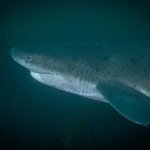by Michael Bear
 Michael Bear is Science Diving Editor for California Diver Magazine and currently contributor to Marine Science Today with over a 1000 cold-water dives, an AAUS (American Academy of Underwater Sciences) Scientific Diver and founder of Sevengill Shark Sightings.org. He lives and work in San Diego.
Michael Bear is Science Diving Editor for California Diver Magazine and currently contributor to Marine Science Today with over a 1000 cold-water dives, an AAUS (American Academy of Underwater Sciences) Scientific Diver and founder of Sevengill Shark Sightings.org. He lives and work in San Diego.
I am not a professional shark researcher–just an experienced San Diego diver who has been diving in the San Diego area since 2000. In October of 2008, I began hearing reports of encounters between local San Diego divers and Sevengill sharks, (Notorynchus cepedianus). At the time, I thought this a bit unusual, since this was the first I had heard of these encounters in nearly a decade of regular diving in the San Diego area and monitoring local Internet dive boards. Between 2000 and 2006, almost no encounters were reported. But in 2008, that all changed and they began appearing on the dive boards and lists, one here, two there, five there, slowing increasing until it was obvious that something was happening–exactly what was not clear–only that more and more encounters were being reported by divers.
Although I put out the word for submissions on local diving boards, I was unprepared for the startling number of responses I received. In the first year alone (2009-2010), over 20 separate Sevengill encounters were logged by local divers, half a dozen photographs and 17 videos were submitted, clearly documenting that these were encounters with N. cepedianus. 4 years later, this has now grown to over 150 photographs and over almost 70 high definition videos, showing Floy tags, mating and bite marks as well as gender–and possibly–the jury is still out on this one: the bite mark of a Cookie Cutter shark (Isistius brasiliensis) on the caudal fin of local Sevengill. So the amount of data in the video database alone provides what we believe are intriguing clues to the activities of this species locally.
It seemed that scientifically, there were (at least) two questions that needed to be answered in the beginning:
1. Have any baseline population studies of this species ever been done locally? If so, this would provide the baseline necessary for an accurate comparison to our numbers over time.
2. Have any studies been done to track the number of divers going into the water over the same period of time? In other words, was this a case of simply more divers entering the water, rather than more sharks being present?
Unfortunately, the answer to both questions above is: no. To my knowledge (and I’ve asked) no baseline studies of N. cepedianus have ever been done by any of the local marine institutions; and no baseline studies have been done locally to survey the number of divers entering the water in the last four years.
This meant, in effect, that I was starting my own long-term baseline study. What started out as a simple spreadsheet in 2009 became slightly more sophisticated in 2010, when Jeffry Gallant, shark researcher with the Shark Research Institute of Canada (SRI) and founder the Greenland Elasmobranch Education Research Group [GEERG] graciously agreed to allow me to merge my database with the more global Shark Observation Network, set up to allow divers to log shark sightings worldwide in a public database–from anywhere in the world, using both ‘hard’ and ‘soft’ data entry fields and a Google Earth-like map to pinpoint geo-location.

Methodology
Data Set #1
When a San Diego diver encounters what he or she believes is a Sevengill shark, the diver visits the website and enters ‘hard’ data about his or her encounter, taken from their dive computer, such as:
- Date and time of the dive.
- Water temperature
- GPS of the location. For popular beaches, this is readily available on Google Earth or Google Maps. If on a boat, hopefully, the GPS for the location can be obtained from the skipper or from the on-board GPS device after the dive.
- The maximum depth during the encounter
Then the diver enters the ‘soft’ data, which is weaker as it relies on memory and perception, both of which can be altered or impaired significantly during an encounter with a large predator:
- Estimated visibility
- Underwater activity during the encounter, such as sightseeing, photographing marine life, spear fishing, etc.
- Estimated size of the shark and its gender
Data Set #2
After all the relevant information has been logged, the diver is given the opportunity to submit photographs or videos taken during the encounter. In many cases, these videos and images have been surprisingly good, especially since the use of high definition video cameras have come into common use now. The idea here is to capture details such as the unique black freckles visible on the head and dorsal areas of Sevengills. It is this unique freckling pattern that we believe can be subjected to analysis by a pattern recognition algorithm 1, similar to the one used by Brad Norman to identify Whale Sharks (Rhincodon typus).2
Data Set #3:
The final data set will be whatever individual sharks can be accurately identified a) by gender and b) by the pattern recognition algorithm--with duplicates and unclear data deleted.
Obviously, only confirmed encounters with N. cepedianus accompanied by photos or video, will be considered from the Shark Observation Network (SON), where the ‘hard data’ will give us date/time/location/water temperature and depth from the divers dive computers.
We are only in the very initial data collection stages of a long-term population dynamics study that is expected to last perhaps a decade, although if useable data can be obtained before then, we would consider making it public.
Acknowledgements
As a citizen scientist, I have been fortunate to have received valuable mentoring and guidance from some very knowledgeable folks in the shark research community, namely Vallorie Hodges, Diving Safety Officer for the Oregon Coast Aquarium, which has 10 Sevengill sharks and David Ebert, Program Manager of the Pacific Shark Research at Moss Landing, California. Both Vallorie and David, although extremely busy with their own research work, have been more than generous with their time and suggestions and have followed the situation down here with interest. Not to be overlooked is Alison Kock, of Shark Spotters in South Africa, who works extensively with both Sevengills and Great White sharks, and who has also shared her knowledge and time selflessly, despite being busy with her own research.
Leave a Reply
You must be logged in to post a comment.